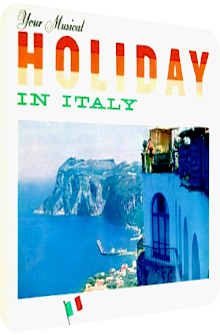
Werner Müller
Holiday In Italy
1956
Holiday In Italy is one part of the travelog series created by German orchestra leader Werner Müller (1920–1998) who is much better known for his international alias Ricardo Santos, because names that end with an “o” are the latest craze in the 50’s and evoke a sense of romance, adventure… and strong arms. And so it happens all too regularly that Müller’s releases are often reissued twice or even thrice, both under his real name and his stage persona, and then in a multitude of different covers. The version that serves as the base for this review is depicted above.
It is the modernized front artwork of the Decca Records release which is also attached to the digital reissue. The Polydor label has its hands in the release cycle as well. What all releases have in common is an identical track order with no omissions whatsoever. Werner Müller gathers his Hamburg-based orchestra and plays 12 Italian standards. I would have loved to write that the orchestra transforms these compositions, but alas, this is not the case. Strings, horns and woodwind devices are on board alright, the problem being the bog-standard appearance of these instruments. On the plus side, there are also pointillistic xylophones, accordions and harmonicas included, and it is these artifacts that turn things around in many a tune. Let’s see what Holiday In Italy has in store… and why it appears on AmbientExotica after all.
The first notes of Luigi Denza’s biggest composition Funiculì, Funiculà already reveal where Werner Müller’s journey is going. Yes, to Italy. But that’s not what I refer to. It is the arrangement I’m hinting at; placed near the archetypically classical core with whirling strings, punctilio counterparts, several harps and spiced with Müller’s trademark horns, this LP is still ablaze with colors and hued in sunlight, but also strikingly streamlined. The traditional Tiritomba, however, turns out to be a surprise in the overall scheme due to the sun-dappled acoustic guitar aorta which pulsates right from the start. Crunchy and immediate, it is soon enough hued by gyring strings and mountainous horns but is nonetheless audible throughout the runtime. Add the occasionally enchanting aerise cavalcades of the violins, and you got a standout track, and a very dreamy one at that, at least arrangement-wise.
While Enrico Toselli’s Serenata genuflects before aqueous vortexes with an attached antediluvian flavor of Baroque romance, Luigi Arditi’s Il Bacio revs up the tempo, shuffles between a Waltz structure and bosky fairy tale tendrils as realized with the help of glistening vibes. The woodwinds and harp round off this festive evergreen. Speaking of evergreens: Eduardo Di Capua’s O Sole Mio is one of the most famous songs all over the world, and so it finds its way into Müller’s travelog easier than anything. A Neapolitan harmonica is in the spotlight, its arpeggio coruscating in-between the Sicilian lutes, auroral strings and soft shakers. Even though this tune has been encountered hundreds of times, it is yet again the arrangement that easily catches the attention. Vincent Scotto’s Vieni, Vieni finishes side A with a fast-paced amalgamation of downwards-spiraling xylophone cataracts and an upbeat tempo, therefore amplifying activity and movement instead of besotted petrification.
Side B keeps the pace, unsurprisingly so: Ernesto De Curtis’s Torna A Surriento is undoubtedly the most doleful, gypsy-like ballad due to a cornucopia of tones in minor, a lead fiddle to induce teary-eyed emotions and contrapuntal sunlight in the shape of liquedous harps and guitar granulomas serving as the backdrop. Eduardo Di Capua’s second composition Maria Mari! meanwhile oscillates between rufescent pompousness and surprisingly recondite yearning before the accordion-accompanied chorus bathes in prismatic luminescence. Whereas Ruggero Leoncavallo’s Mattinata is a genuinely languorous piece due to the non-shoddy aura of romance and great polyphony between the harps and violins, Alberto Pestalozza’s Ciribiribin is a 3/4 hymn whose good-natured tone sequences and interesting ornamentation in the shapes of accordions and xylophone droplets make it another considerably good piece.
Afterwards, Eldo Di Lazarro’s Reginella Campagnola proves to be a nocturnal-silvery take on the uptempo source material before the magnanimous string washes bring in the sunlight, all the while the traditional finale Santa Lucia is presented here as a mucoid rivulet of glorifying strings, exalting even the last ray of light. Flutes, woodwinds, horns and the vivacity of the classical stringed instruments are the endpoint to a travelog that is now seemingly adrift.
Holiday In Italy showcases the curse of a collector’s life better than any other of Werner Müller aka Ricardo Santos’ Holiday travelogs. Just use the Search function to find plenty of analogical LP's… I somehow inherited them all. It is basically incompatible with the specific needs of an Exotica fan, simply too darn standardized and situated in classical realms. But a devoted collector has to fetch all of its respective parts, and probably worse, all of the versions out there with their different covers and sound qualities. This isn’t bad news per se, but it probably explains why this album appears here on AmbientExotica. It is not that Italian albums aren’t ostracized.
However, albums such as the Irving Fields Trio’s Pizzas And Bongos (1961) or Barney Kessel’s Reflections In Rome (1970) are of greater value to the aficionado’s senses. Holiday In Italy is simply too streamlined and normal. Having said that, the arrangements are top notch and indeed somewhat varied. Once the harmonica, accordion or aroeggio of the lute are in the spotlight, that stereotypical Italian flavor unfolds and leaves an auroral aftertaste. Songs like Vieni, Vieni and even O Sole Mio – of all things! – push the album to its peak thanks to the golden polyphony. It is best to see the album as what it truly is: a travelog. And with this epiphany comes the reflection in terms of one’s own heritage. Italians will roll their eyes, but listeners all around the world might find a great sparkler in-between the cracks more often than not. And cherry-picking is entirely possible, since Holiday In Italy has been reissued as a digital download and can thus be cross-checked.
Exotica Review 385: Werner Muller – Holiday In Italy (1956). Originally published on Nov. 1, 2014 at AmbientExotica.com.
